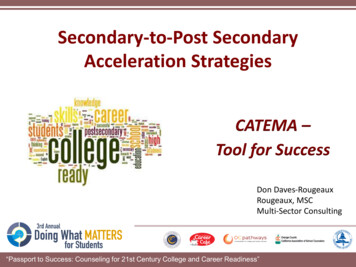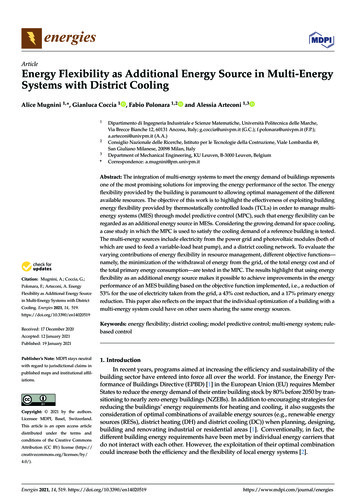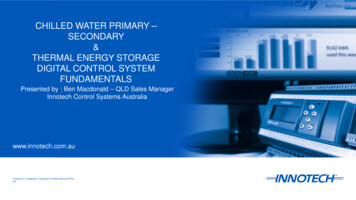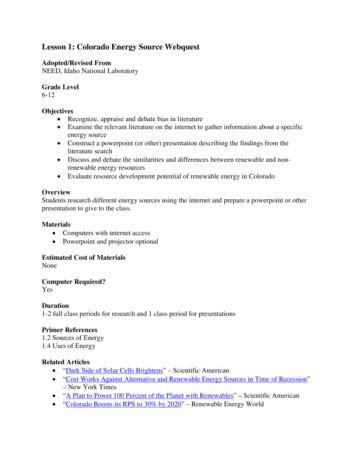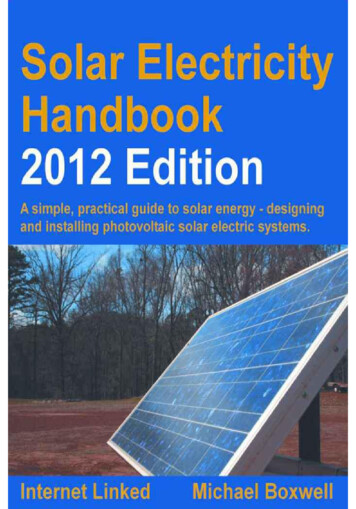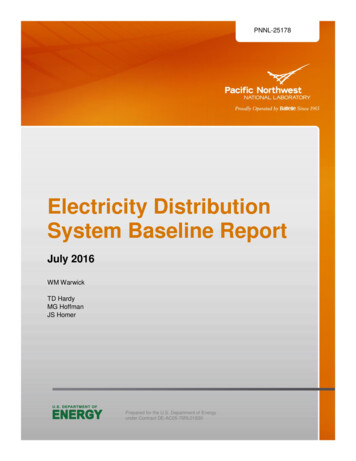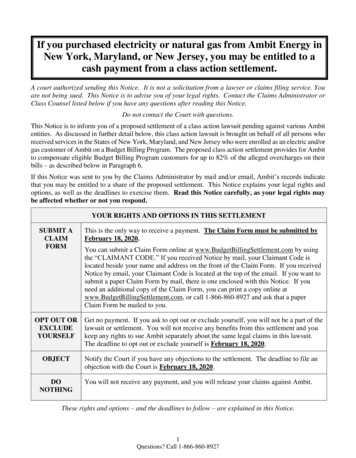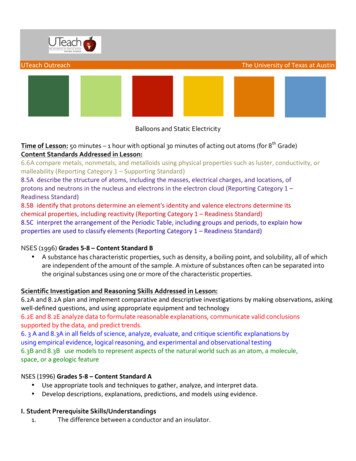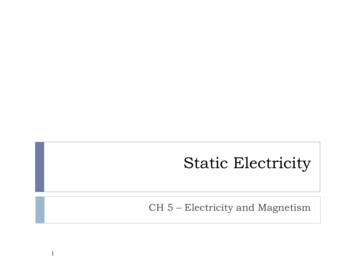
Transcription
ELECTRICITY - A Secondary Energy SourceA Secondary SourceThe Science of ElectricityHow Electricity is Generated/MadeThe Transformer - Moving ElectricityMeasuring Electricityenergy calculatorlinks pagerecent statisticsA SECONDARY SOURCEElectricity is the flow of electrical power or charge. It is a secondary energy source whichmeans that we get it from the conversion of other sources of energy, like coal, natural gas,oil, nuclear power and other natural sources, which are called primary sources. The energysources we use to make electricity can be renewable or non-renewable, but electricity itselfis neither renewable or non-renewable.Electricity is a basic part of nature and it is one of our most widely used forms ofenergy. Many cities and towns were built alongside waterfalls (a primary source ofmechanical energy) that turned water wheels to perform work. Before electricitygeneration began over 100 years ago, houses were lit with kerosene lamps, food was cooledin iceboxes, and rooms were warmed by wood-burning or coal-burning stoves. Beginningwith Benjamin Franklin's experiment with a kite one stormy night in Philadelphia, theprinciples of electricity gradually became understood. Thomas Edison helped changeeveryone's life -- he perfected his invention -- the electric light bulb. Prior to 1879, directcurrent (DC) electricity had been used in arc lights for outdoor lighting. In the late-1800s,Nikola Tesla pioneered the generation, transmission, and use of alternating current (AC)electricity, which can be transmitted over much greater distances than direct current.Tesla's inventions used electricity to bring indoor lighting to our homes and to powerindustrial machines.Despite its great importance in our daily lives, most of us rarely stop to think what lifewould be like without electricity. Yet like air and water, we tend to take electricity forgranted. Everyday, we use electricity to do many jobs for us -- from lighting andheating/cooling our homes, to powering our televisions and computers. Electricity is acontrollable and convenient form of energy used in the applications of heat, light andpower.THE SCIENCE OF ELECTRICITY developed by the National Energy Education Development ProjectIn order to understand how electric charge moves from one atom to another, we need toknow something about atoms. Everything in the universe is made of atoms—every star,every tree, every animal. The human body is made of atoms. Air and water are, too. Atomsare the building blocks of the universe. Atoms are so small that millions of them would fit
on the head of a pin.Atoms are made of even smaller particles. The center of an atom is called the nucleus. It ismade of particles called protons and neutrons. The protons and neutrons are very small,but electrons are much, much smaller. Electrons spin around the nucleus in shells a greatdistance from the nucleus. If the nucleus were the size of a tennis ball, the atom would bethe size of the Empire State Building. Atoms are mostly empty space.If you could see an atom, it would look a little like atiny center of balls surrounded by giant invisiblebubbles (or shells). The electrons would be on thesurface of the bubbles, constantly spinning andmoving to stay as far away from each other as possible.Electrons are held in their shells by an electrical force.The protons and electrons of an atom are attracted toeach other. They both carry an electrical charge. Anelectrical charge is a force within the particle. Protonshave a positive charge ( ) and electrons have anegative charge (-). The positive charge of the protonsis equal to the negative charge of the electrons. Opposite charges attract each other. Whenan atom is in balance, it has an equal number of protons and electrons. The neutrons carryno charge and their number can vary.The number of protons in an atom determines the kindof atom, or element, it is. An element is a substance inwhich all of the atoms are identical (the Periodic Tableshows all the known elements). Every atom ofhydrogen, for example, has one proton and oneelectron, with no neutrons. Every atom of carbon hassix protons, six electrons, and six neutrons. Thenumber of protons determines which element it is.Electrons usually remain a constant distance from thenucleus in precise shells. The shell closest to thenucleus can hold two electrons. The next shell can holdup to eight. The outer shells cans hold even more.Some atoms with many protons can have as many as seven shells with electrons in them.The electrons in the shells closest to the nucleus have a strong force of attraction to theprotons. Sometimes, the electrons in the outermost shells do not. These electrons can bepushed out of their orbits. Applying a force can make them move from one atom toanother. These moving electrons are electricity.STATIC ELECTRICITYElectricity has been moving in the world forever. Lightning is a form of electricity. It iselectrons moving from one cloud to another or jumping from a cloud to the ground. Haveyou ever felt a shock when you touched an object after walking across a carpet? A stream ofelectrons jumped to you from that object. This is called static electricity.Have you ever made your hair stand straight up by rubbing a balloon on it? If so, yourubbed some electrons off the balloon. The electrons moved into your hair from theballoon. They tried to get far away from each other by moving to the ends of your hair.
They pushed against each other and made your hair move—they repelled each other. Justas opposite charges attract each other, like charges repel each other.MAGNETS AND ELECTRICITYThe spinning of the electrons around the nucleus of an atom creates a tiny magnetic field.Most objects are not magnetic because the atoms are arranged so that the electrons spin indifferent, random directions, and cancel out each other.Magnets are different; the molecules in magnets are arranged so that the electrons spin inthe same direction. This arrangement of atoms creates two poles in a magnet, a Northseeking pole and a South-seeking pole.Bar MagnetA magnet is labeled with North (N) and South (S) poles. The magnetic force in a magnetflows from the North pole to the South pole. This creates a magnetic field around amagnet.Have you ever held two magnets close to each other? They don’t act like most objects. Ifyou try to push the South poles together, they repel each other. Two North poles also repeleach other.Turn one magnet around and the North (N) and the South (S) poles are attracted to eachother. The magnets come together with a strong force. Just like protons and electrons,opposites attract.These special properties of magnets can be used to make electricity. Moving magneticfields can pull and push electrons. Some metals, like copper have electrons that are loosely
held. They can be pushed from their shells by moving magnets. Magnets and wire are usedtogether in electric generators.BATTERIES PRODUCE ELECTRICITYA battery produces electricity using twodifferent metals in a chemical solution. Achemical reaction between the metals and thechemicals frees more electrons in one metalthan in the other. One end of the battery isattached to one of the metals; the other end isattached to the other metal. The end that freesmore electrons develops a positive charge andthe other end develops a negative charge. If awire is attached from one end of the battery tothe other, electrons flow through the wire tobalance the electrical charge. A load is a devicethat does work or performs a job. If a load––such as a lightbulb––is placed along the wire,the electricity can do work as it flows through the wire. In the picture above, electrons flowfrom the negative end of the battery through the wire to the lightbulb. The electricity flowsthrough the wire in the lightbulb and back to the battery.ELECTRICITY TRAVELS IN CIRCUITSElectricity travels in closed loops, or circuits (from the word circle). It must have acomplete path before the electrons can move. If a circuit is open, the electrons cannot flow.When we flip on a light switch, we close a circuit. The electricity flows from the electricwire through the light and back into the wire. When we flip the switch off, we open thecircuit. No electricity flows to the light. When we turn a light switch on, electricity flowsthrough a tiny wire in the bulb. The wire gets very hot. It makes the gas in the bulb glow.When the bulb burns out, the tiny wire has broken. The path through the bulb is gone.When we turn on the TV, electricity flows through wires inside the set, producing picturesand sound. Sometimes electricity runs motors—in washers or mixers. Electricity does a lotof work for us. We use it many times each day.HOW ELECTRICITY IS GENERATEDA generator is a device that converts mechanical energy into electrical energy. The processis based on the relationship between magnetism and electricity. In 1831, Faradaydiscovered that when a magnet is moved inside a coil of wire, electrical current flows in the
wire.A typical generator at a power plant uses an electromagnet—a magnet produced byelectricity—not a traditional magnet. The generator has a series of insulated coils of wirethat form a stationary cylinder. This cylinder surrounds a rotary electromagnetic shaft.When the electromagnetic shaft rotates, it induces a small electric current in each sectionof the wire coil. Each section of the wire becomes a small, separate electric conductor. Thesmall currents of individual sections are added together to form one large current. Thiscurrent is the electric power that is transmitted from the power company to the consumer.An electric utility power station uses either aturbine, engine, water wheel, or other similarmachine to drive an electric generator or a devicethat converts mechanical or chemical energy togenerate electricity. Steam turbines, internalcombustion engines, gas combustion turbines,water turbines, and wind turbines are the mostcommon methods to generate electricity. Mostpower plants are about 35 percent efficient. Thatmeans that for every 100 units of energy that gointo a plant, only 35 units are converted to usableelectrical energy.Most of the electricity in the United States isproduced in steam turbines. A turbine convertsthe kinetic energy of a moving fluid (liquid or gas)to mechanical energy. Steam turbines have aseries of blades mounted on a shaft against whichsteam is forced, thus rotating the shaft connectedto the generator. In a fossil-fueled steam turbine,the fuel is burned in a furnace to heat water in aboiler to produce steam. Coal, petroleum (oil),and natural gas are burned in large furnaces toheat water to make steam that in turn pushes onthe blades of a turbine.Did you know that most electricity generated inthe United State comes from burning coal? In2007, nearly half (48.5%) of the country's 4.1trillion kilowatthours of electricity used coal as its source of energy.Natural gas, in addition to being burned to heat water for steam, can also be burned toproduce hot combustion gases that pass directly through a turbine, spinning the blades ofthe turbine to generate electricity. Gas turbines are commonly used when electricity utilityusage is in high demand. In 2007, 21.6% of the nation's electricity was fueled by naturalgas.Petroleum can also be used to make steam to turn a turbine. Residual fuel oil, a productrefined from crude oil, is often the petroleum product used in electric plants that usepetroleum to make steam. Petroleum was used to generate about two percent (2%) of allelectricity generated in U.S. electricity plants in 2007.Nuclear power is a method in which steam is produced by heating water through a process
called nuclear fission. In a nuclear power plant, a reactor contains a core of nuclear fuel,primarily enriched uranium. When atoms of uranium fuel are hit by neutrons they fission(split), releasing heat and more neutrons. Under controlled conditions, these otherneutrons can strike more uranium atoms, splitting more atoms, and so on. Thereby,continuous fission can take place, forming a chain reaction releasing heat. The heat is usedto turn water into steam, that, in turn, spins a turbine that generates electricity. Nuclearpower was used to generate 19.4% of all the country's electricity in 2007.Hydropower, the source for 5.8% of U.S. electricity generation in 2007, is a process inwhich flowing water is used to spin a turbine connected to a generator. There are two basictypes of hydroelectric systems that produce electricity. In the first system, flowing wateraccumulates in reservoirs created by the use of dams. The water falls through a pipe calleda penstock and applies pressure against the turbine blades to drive the generator toproduce electricity. In the second system, called run-of-river, the force of the river current(rather than falling water) applies pressure to the turbine blades to produce electricity.Geothermal power comes from heat energy buried beneath the surface of the earth. Insome areas of the country, enough heat rises close to the surface of the earth to heatunderground water into steam, which can be tapped for use at steam-turbine plants. Thisenergy source generated less than 1% of the electricity in the country in 2007.Solar power is derived from the energy of the sun. However, the sun's energy is notavailable full-time and it is widely scattered. The processes used to produce electricityusing the sun's energy have historically been more expensive than using conventional fossilfuels. Photovoltaic conversion generates electric power directly from the light of the sun ina photovoltaic (solar) cell. Solar-thermal electric generators use the radiant energy fromthe sun to produce steam to drive turbines. In 2007, less than 1% of the nation's electricitywas based on solar power.Wind power is derived from the conversion of the energy contained in wind into electricity.Wind power, less than 1% of the nation's electricity in 2007, is a rapidly growing source ofelectricity. A wind turbine is similar to a typical wind mill.Biomass includes wood, municipal solid waste (garbage), and agricultural waste, such ascorn cobs and wheat straw. These are some other energy sources for producing electricity.These sources replace fossil fuels in the boiler. The combustion of wood and waste createssteam that is typically used in conventional steam-electric plants. Biomass accounts forabout 1% of the electricity generated in the United States.THE TRANSFORMER - MOVING ELECTRICITYTo solve the problem of sending electricity overlong distances, William Stanley developed adevice called a transformer. The transformerallowed electricity to be efficiently transmittedover long distances. This made it possible tosupply electricity to homes and businesseslocated far from the electric generating plant.The electricity produced by a generator travels along cables to a transformer, whichchanges electricity from low voltage to high voltage. Electricity can be moved longdistances more efficiently using high voltage. Transmission lines are used to carry theelectricity to a substation. Substations have transformers that change the high voltageelectricity into lower voltage electricity. From the substation, distribution lines carry the
electricity to homes, offices and factories, which require low voltage electricity.MEASURING ELECTRICITYElectricity is measured in units of power called watts. It was named to honor James Watt,the inventor of the steam engine. One watt is a very small amount of power. It wouldrequire nearly 750 watts to equal one horsepower. A kilowatt represents 1,000 watts. Akilowatthour (kWh) is equal to the energy of 1,000 watts working for one hour. Theamount of electricity a power plant generates or a customer uses over a period of time ismeasured in kilowatthours (kWh). Kilowatthours are determined by multiplying thenumber of kW's required by the number of hours of use. For example, if you use a 40-wattlight bulb 5 hours a day, you have used 200 watthours, or 0.2 kilowatthours, of electricalenergy. See our Energy Calculator section to learn more about converting units.Last Revised: May 2009Sources: Energy Information Administration, Annual Energy Review 2007, August 2008 .The National Energy Education Development Project, Intermediate Energy Infobook, 2007.EIA Main Home Page Related Links Kid's Page Privacy Contact Us
When we flip on a light switch, we close a circuit. The electricity flows from the electric wire through the light and back into the wire. When we flip the switch off, we open the circuit. No electricity flows to the light. When we turn a light switch on, electricity flows
